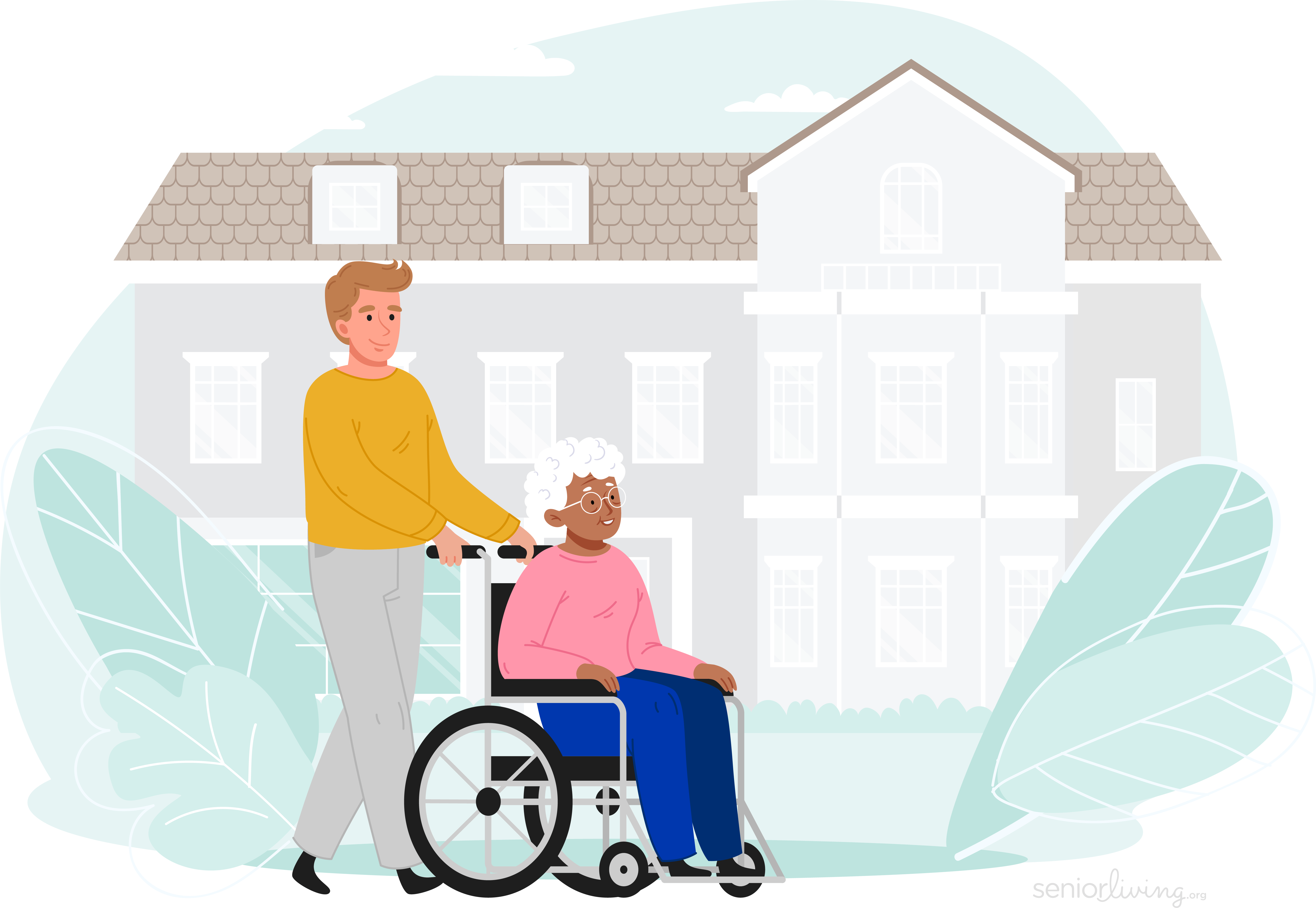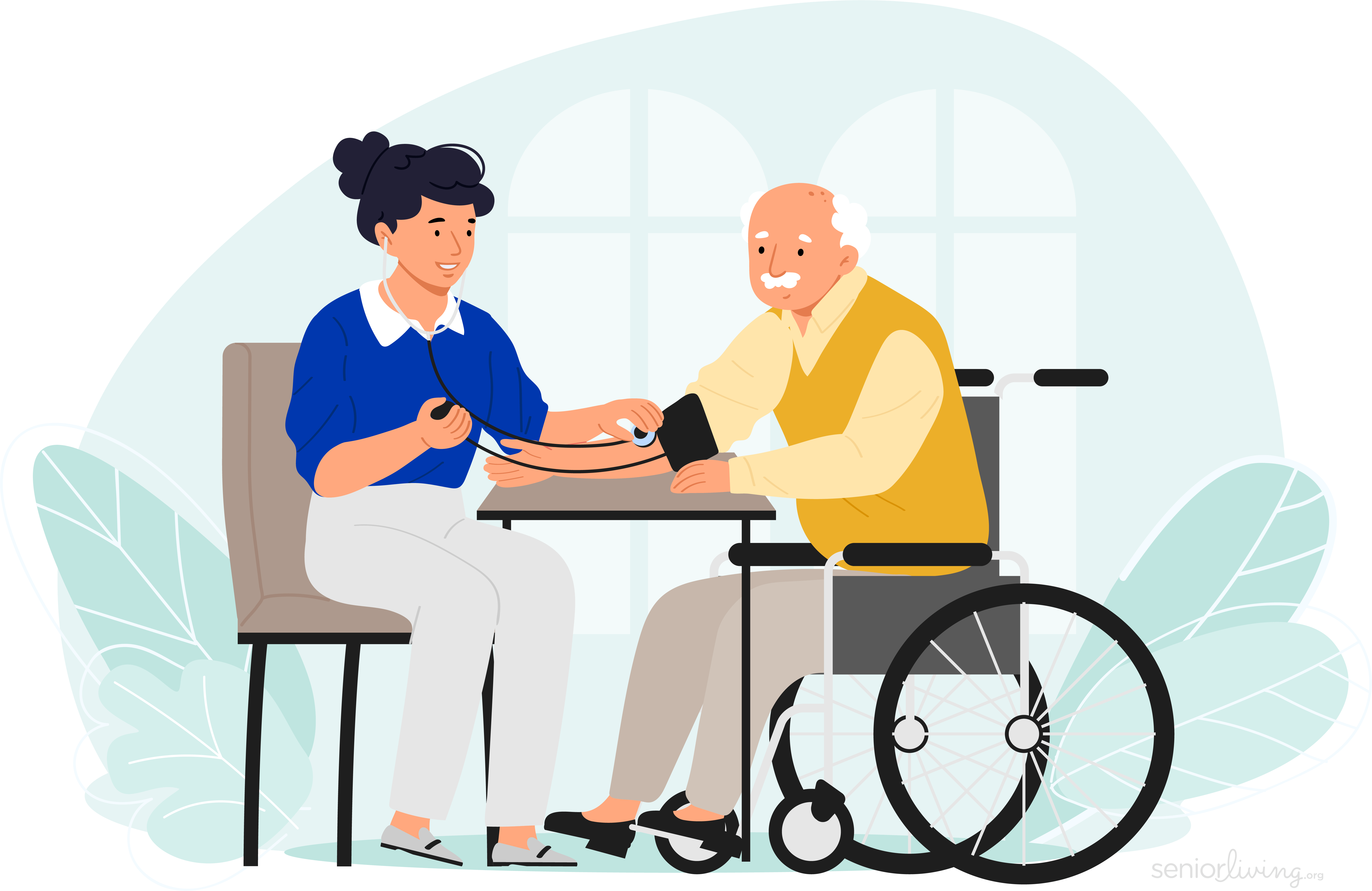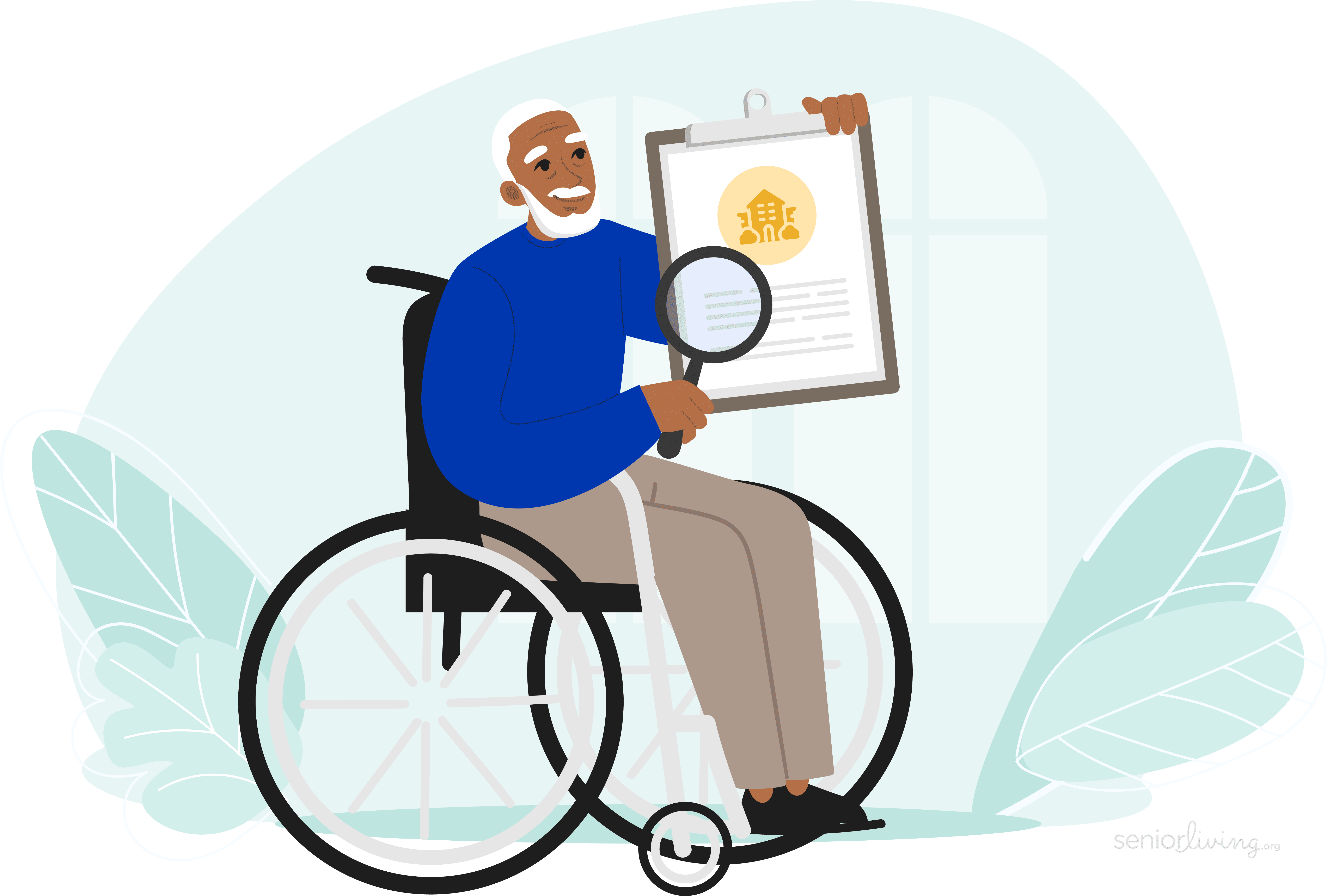Can You Be in a Wheelchair in Assisted Living?
A Guide to Assisted Living for Wheelchair Users in 2024
SeniorLiving.org is supported by commissions from providers listed on our site. Read our Editorial Guidelines
Find Assisted Living Near You
Join 1,019,247 Seniors Who've Searched for Housing Communities on SeniorLiving.org.
Find Assisted Living Near You
Accessibility in public spaces has improved tremendously since the passage of the Americans with Disabilities Act of 1990. Known as the ADA, the act prohibits discrimination against disabled Americans at work and in public spaces, which includes assisted living facilities (although the laws do not mention assisted living communities specifically). This means that assisted living communities across the country have built or updated their facilities according to ADA guidelines, so they’re better able to accommodate older adults who use a wheelchair or who have other challenges.
Assisted living facilities aren’t just regulated by the federal government, however. Laws regarding how assisted living facilities and other types of housing for seniors serve or accept residents vary state to state. States have different definitions of “ambulatory,” for example, so it can be murky trying to figure out whether a state legally allows an assisted living facility to reject an applicant who is unable to get in and out of a wheelchair without some assistance. If states word their guidelines in ways that might be open to interpretation, it could mean that assisted living communities in some states have some legal leeway in rejecting applicants who use wheelchairs. (Although if they aren’t careful about this, they could be vulnerable to legal action.1)
Assisted living can be a great environment for older adults in a wheelchair. Having access to accessible common areas and transportation, via a community vehicle equipped to transport wheelchair users, can increase a sense of independence and open up new and frequent opportunities to socialize. Choosing the best assisted living community for you or a loved one is always a big decision, with numerous important considerations. And it can be extra challenging for older adults who use a wheelchair. In this guide, we’ll cover what you need to know about navigating the assisted living landscape as a wheelchair user.
Table of Contents
What Is Assisted Living?

Assisted living companies might be privately owned or run by nonprofit or religious organizations. Many assisted living communities also offer independent living, memory care, and skilled nursing as well, in the same building or in different buildings on the same property or on a nearby property.
» Related Reading: Nonprofit Senior Living
Guidelines for assisted living communities can differ state to state. But generally, these facilities are licensed by states to provide housing, property maintenance, meals, and the option of assistance with activities of daily living (ADLs), such as bathing, dressing, toileting, and medication management, depending on residents’ individual needs. They also often provide light housekeeping, group activities, and transportation, sometimes for extra fees.
In general, older adults who would benefit from some extra support are great candidates for assisted living. For example, older homeowners who are no longer interested in or able to keep up on home and lawn care might enjoy not having to deal with that sort of maintenance anymore. Assisted living facilities also typically make support staff available to residents 24/7 in case of an emergency. This can increase residents’ peace of mind knowing that they’re not alone if they need help. Assisted living residents also enjoy the many opportunities for socializing during on-site activities and off-site trips, which are standard amenities at most assisted living communities.
Did You Know? Seven in 100 older adults over 65 use a wheelchair.2 And more than 18 million people over 65 have some disability.3
Residents who need help with more than a few ADLs or who have Alzheimer’s or dementia might be better suited for memory care or skilled nursing care rather than assisted living. Hiring a home health aide is another option for older adults who might need more care and assistance than assisted living can provide.
Can You Be in a Wheelchair in Assisted Living?
The short answer is “absolutely.” Assisted living facilities are required by federal law to provide reasonable accommodations to adults who use a wheelchair, and many communities welcome wheelchair users with open arms.
But regulations regarding assisted living communities are different in each state. Some states include language in their licensing regulations and guidelines that can be vague or open to interpretation, meaning that some assisted living facilities might be allowed to reject assisted living applicants who are unable to walk on their own without assistance. In some states, therefore, a person who needs the help of one or more people to get in and out of their chair may be told a skilled nursing facility might be a better fit for them.
» You Might Also Like: Support and Resources for Family Caregivers
Benefits of Assisted Living for Wheelchair-Bound Seniors

- Accessibility: Because assisted living communities need to adhere to ADA requirements, they typically have more accessibility features than a residential house or apartment. These might include grab bars; wider doors; ramps, lifts, and elevators; non-skid flooring; and emergency response systems in individual units. If you or a loved one is new to using a wheelchair, it can be more convenient — and less expensive — to have these design elements already in place rather than renovate a home to make it more wheelchair-accessible.
- Help with maintenance and daily tasks: Assisted living communities typically take care of utilities, upkeep of the home and grounds, and meals, making life easier for residents. In addition, assisted living residents can opt for help with ADLs, such as bathing, dressing, toileting, and medication management.
- Transportation: Many assisted living communities offer residents transportation (typically vans) with a wheelchair lift, making getting out and about easier. Converting a private vehicle for wheelchair accessibility can cost tens of thousands of dollars.
- Convenience of on-site health services: Some assisted living communities offer health services, such as X-rays, labs, and physical and occupational therapy, within the community. This reduces the amount of travel residents need to do to manage their health.
- Enhanced safety: Assisted living communities typically have staff on hand 24/7 to assist residents in the event of an emergency. Some communities offer 24/7 access to registered nurses as well if residents need assistance (although this is often for an extra fee).
- Opportunity to socialize: Many assisted living communities have large, comfortable common areas where residents can gather for games, fitness, movies, lectures, and happy hours. An older adult who uses a wheelchair might find it convenient to get together with friends without the need to travel away from their home.
Did You Know? A study of veterans who use wheelchairs found that poor posture was associated with more pain and illness, highlighting the benefits of exercise to improve posture.4
Federal Accessibility Regulations for Assisted Living
Disabled people are considered a protected class in the U.S., which means it’s illegal to discriminate against them.5 Here are the federal government regulations that pertain to adults who use a wheelchair.
Americans with Disabilities Act (ADA)
The ADA prohibits discrimination against individuals with disabilities in public accommodations, which includes assisted living facilities. This means communities must provide reasonable accommodations to ensure equal access for individuals with disabilities, including those using wheelchairs.
Facilities built before 1990 are required to update or provide alternative routes of access to comply with ADA regulations so disabled people have full and equal access in all areas of the facility. “Path of travel” requirements are meant to ensure restrooms, telephones, and drinking fountains are accessible to people with disabilities. The law also specifies that spaces where people assemble together accommodate people using wheelchairs with elevators, lifts, or ramps.
Learn More: You can read about the requirements regarding mobility devices and aids from the U.S. Department of Justice’s Civil Rights Division.
Section 504 of the Rehabilitation Act
If an assisted living facility accepts federal funds, it might be subject to this law, which prohibits discrimination based on disability in “programs and activities.” This section of the law refers to an organization that is “principally engaged in the business of providing education, health care, housing, social services, or parks and recreation,” which might apply to assisted living facilities.
Architectural Barriers Act (ABA)
This law says that buildings that were designed, built, or altered with federal funds or leased by federal agencies after Aug. 12, 1968, must be accessible for disabled people.
FYI: Performing a medical exam on a patient in a wheelchair is permissible only in certain circumstances. Examination while seated can be less thorough, so it might violate rules requiring equal access to patients in wheelchairs.6
Is Assisted Living Right for Me?
Although assisted living communities are not allowed to discriminate against potential residents who use a wheelchair, some facilities still may not have enough trained staff to accommodate your loved one’s need for assistance. Carefully consider options to ensure a move to assisted living is not a frustrating, unsafe, or uncomfortable experience for your loved one.
Assisted living communities that prioritize accessibility features can be a great living option for older adults who use a wheelchair. However, some assisted living facilities are not licensed by the state to provide care for people who need more than one person to assist them getting in and out of their chairs. In those cases, the community might refer applicants to skilled nursing facilities that can better accommodate their needs.
» Learn About: ADA Standards for Accessible Design
Assisted living facilities are required by law to provide accessible building features such as ramps, doorways, and rooms wide enough for wheelchair users to turn around in (rather than needing to back out of tight spaces). But, ideally, someone who is able to get in and out of a wheelchair on their own will likely have an easier time maintaining a sense of independence and comfort in assisted living.
If you or a loved one requires assistance from one person when getting in and out of a chair, it would be a good idea to prioritize a community with a high caregiver-to-resident ratio. Assisted living communities experiencing staff shortages might be less likely to give residents in a wheelchair the timely care and service they need. It’s also a good idea to ask whether staff has been trained to assist wheelchair users.
Choosing the best assisted living community for you or a loved one will depend on many individual factors. But potential residents who use a wheelchair will want to consider which floor apartments, services, and amenities are located on and how easy or difficult it could be to access them. For example, a community that won’t require you to use an elevator to get to meals and other services might feel more convenient (not to mention safer, if the need to evacuate in an emergency arises).
Communities that have implemented universal design elements to increase accessibility in individual units and common areas can have a positive impact on the sense of independence and quality of life of wheelchair users. Such features can make daily living for disabled older adults much easier and more comfortable.
Some accessible design elements are typical in senior living environments, such as grab bars in bathrooms and step-in showers with seating for bathing. Accessible design has become more sophisticated in recent years. So, in some assisted living apartments, you might find lower light switches and countertops, knobs and climate controls that are easier to grab and turn, and emergency call systems. Universal design can be a great benefit for many seniors, particularly for those who use a wheelchair.
When comparison-shopping for assisted living for an adult who uses a wheelchair, keep care costs in mind; each ADL that residents need help with is likely to increase the total monthly cost.
How Much Does Assisted Living Cost?
The median assisted living cost for 2024 is estimated to be $4,917 per month.7 Monthly costs might be higher or lower in your city or state.
Be aware that communities typically charge extra fees for personal care services, such as assistance with ADLs; some excursions and amenities; and even meals. These additions can significantly increase the total monthly cost of assisted living. Starting assisted living fees also vary widely depending on community location and services and amenities available.
Paying for Assisted Living
Many people pay for assisted living expenses out of pocket or with help from a long-term care insurance policy. Some older adults sell their homes or take out a reverse mortgage on their home to help pay for long-term care expenses. The federal government insures one type of reverse mortgage: a Home Equity Conversion Mortgage (HECM), which is available only through a Federal Housing Administration (FHA) approved lender. This reverse mortgage program enables homeowners to take out a portion of their home's equity to use for home maintenance, repairs, or general living expenses.
Very low income disabled people might qualify for Supplemental Security Income (SSI). Recipients who meet eligibility requirements (such as income, for example) might be able to use Medicaid waiver funds to help pay for assisted living or services in assisted living, depending on the state they live in. Some states have programs partially funded by Medicaid that help pay for assisted living for qualified older adults to help keep them out of nursing homes.
Veterans who are homebound, have limited eyesight, or need assistance with ADLs might be eligible for Aid and Attendance benefits. These benefits are additional funds added to veterans’ pensions to pay for long-term care. Veterans benefits won’t cover room and board but might cover some care or services for veterans in assisted living. You can apply to live in one of two veterans retirement homes: one in Washington, D.C., and the other in Gulfport, Mississippi. Visit the website of the Armed Forces Retirement Home to learn more.
Resources to Help Wheelchair Users Find Assisted Living

The U.S. Department of Health and Human Services provides a links page to services in your state to get you started. If you qualify for Medicaid, there might be programs in your state that help Medicaid recipients with ADLs, housekeeping, transportation, or medical equipment.
Also try searching the Eldercare Locator, an online database provided by the Administration for Community Living. There you can find information about available housing, support services, and transportation help for people who use a wheelchair. You can also research additional resources for older adults with disabilities, or organizations specifically for wheelchair users, to find information and funding options to help you find the best assisted living for you.
You can also try narrowing your search to find resources geared toward specific groups. The nonprofit Wheelchair Foundation provides information about charities that work with the disabled to provide wheelchairs, other supplies, and services to people who qualify for donations. Veterans might find help by visiting the Warrior Care Recovery Coordination Program, which offers caregiver support resources for wounded or ill former military service members. Veterans can also search the National Resource Directory for information about rehabilitation and other services available to veterans and their families.
The National Resource on Native American Aging’s Native Elder Service Locator is a state-by-state guide to services for tribal elders in states that offer them, including help with nonmedical aspects of daily living in assisted living settings.
Here are some examples of state and county resources available for older adults and those who use a wheelchair:
- Older adults in Arizona might qualify for long-term care benefits, including services in assisted living.
- In California, residents in certain counties who have care needs that qualify them for Medi-Cal may also qualify for an Assisted Living Waiver (ALW) or a Home and Community-Based Services (HCBS) waiver.
- Connecticut has a Home Care Program for Elders designed for state residents age 65 and older who are at risk for nursing home placement. They can apply for some services if they meet financial and health eligibility requirements. And, if they qualify, they can get help with personal care and household duties.
- Colorado residents with significant care needs may be eligible for the state’s Elderly, Blind, and Disabled Waiver, which helps provide long-term support services.
- People age 60 and older who are Florida residents and meet income and other eligibility requirements can receive a basic subsidy of $160 per month. This subsidy can be used for wheelchairs, accessibility modifications, and medications through the state’s Home Care for the Elderly Program. The state Department of Elder Affairs operates 11 Aging and Disability Resource Centers to put eligible seniors in touch with long-term care resources, such as helping pay for wheelchairs, transportation, help with ADLs, personal emergency response systems (PERSs), occupational therapy, and medication management. Adults on Medicaid who might qualify can get help finding assisted living options as well.
- Hawaii has an Executive Office on Aging and Long-Term Care Ombudsman Program that connects Hawaiian seniors with resources for finding alternatives to nursing homes and paying for long-term care.
- The Frail Elderly Waiver for Kansas residents can provide care needs in assisted living above room and board for older adults who qualify for the program.
- The Department of Health and Human Services’ Office of Aging and Disability Services in Maine provides information about services for seniors with disabilities, including long-term care options, help applying for Medicaid, and referrals for aid programs such as transportation, assistive technology, and home care. The state of Maine also offers an online directory for locating licensed assisted living facilities in your area.
- Nevada Care Connection is a one-stop online shop to find resources for older adults and people with disabilities in Nevada. Visitors also can search a directory to find licensed assisted living facilities organized by city or county.
- The Aging and Adult Services’ Long-Term Care Ombudsman Program can help families in North Carolina navigate long-term care and housing options and provide guidance about applying for Medicare and Medicaid benefits.
- Disability Rights Oregon offers information about housing rights of the disabled in Oregon.
- Washington state’s Community Living Connections’ Long-Term Services and Supports supports personal care services, such as bathing, dressing, transportation, and facility-based services like assisted living, skilled nursing, and memory care. The nonprofit Disability Rights Washington connects qualified recipients with funding for assistive technology.
FHJC. (2021). Settlement Reached in Disability Lawsuit Against Operator of Assisted Living Program.
Elsevier. (2023). Understanding Wheelchair Use in Older Adults From the National Health and Aging Trends Study.
United States Census Bureau. (2023). Selected Social Characteristics in the United States.
Rehabilitation Nursing. (2021). Wheelchair Seated Posture and Health Outcomes of Older Veterans in Community Living Centers.
ADA.gov. (2024). Introduction to the Americans with Disabilities Act.
ADA.gov. (2024). Access to Medical Care for Individuals with Mobility Disabilities.
Genworth. (2024). Cost of Care Survey.
